Final report for LS19-309
Project Information
The word biostimulant is used to describe a collection of products that contain ‘effective’ microorganisms (informally called bugs in a jug) and/or plant or animal derived constituents that are alleged to stimulate plant growth and improve crop yield and soil health. They are marketed as being more sustainable alternative and/or supplements to conventional agrochemicals. The biostimulant market in the USA is growing rapidly but there has been limited research to test their efficacy. We are proposing to address this gap in research. Biostimulants are often used in blueberry production, which is one of the fastest growing agricultural sectors in the Southeast, and Georgia is one of the leading growers.
Our project fits in the blueberry production system, with a focus on the response of soil microorganisms to application of biostimulants and how that in turn affects the growth of blueberries. Microorganisms drive soil processes that are essential for the sustainability of the system. As such, the soil biological health is a crucial component of the overall sustainability of the blueberry production system. The use of inputs that promote the soil biological health will therefore strengthen the system by contributing to its overall sustainability.
Our project is highly relevant to sustainable agriculture. Biostimulants often contain bacterial and fungal inoculants that have the potential to enhance plant nutrient availability and prevent diseases. The supply of labile sources of organic matter from biostimulants has also the potential to enhance the beneficial services of the indigenous soil microorganisms. As such, the availability and use of effective biostimulants may decrease the reliance on some traditional agrochemicals. It can also address the lack of alternative products for organic farming and play an important role in recycle wastes that often are the sources of ingredients for biostimulants. Our proposal employs systems approach as it addresses multiple components of the system — blueberry, soil health and growers. It also includes multiple stakeholders and experts to address several components of the system.
The project objectives are:
- Characterize Georgia blueberry growers’ experience and expertise in using biostimulants.
- Determine the impact of biostimulants on blueberry growth and postharvest fruit quality characteristics in greenhouse and field studies.
- Determine the impact of biostimulants on soil biological health and relationship between soil biological health and blueberry plant growth and postharvest fruit quality characteristics.
- Develop educational materials on selection, use and evaluation of biostimulants for growers.
Cooperators
- (Researcher)
- (Researcher)
- - Producer
- - Producer
Research
This report covers some of the work done under Objectives 1, 2 and 3. Objective 1 was to characterize Georgia blueberry growers’ experience and expertise in using biostimulants. Objectives 2 & 3 were to determine the impact of biostimulants on blueberry growth and soil biological growth in a greenhouse and field studies.
Materials and methods
Objective 1: Characterize Georgia blueberry growers’ experience and expertise in using biostimulants
- To understand key issues of importance to Georgia blueberry growers and to develop an initial understanding of how growers talk about biostimulants, 35 to 40 hrs of participant observations were made in eight in-person and virtual blueberry networking and education events early in the project period.
- Survey of Georgia blueberry growers was developed following Scherm et al. (2001) after participant observations. The survey was distributed to approximately 500 individuals through an online UGA Extension listserv of blueberry industry stakeholders, as well as in-person and virtual education events. This survey served multiple purposes of providing background information about the practices of GA blueberry growers, their research priorities, and to identify growers willing to participate in one-to-one interview. The survey data was analyzed using the statistical software package JMP 14 for the Social Sciences. Descriptive analyses were used on both quantitative and categorical variables.
- Semi-structured interviews (n=10) were also conducted. Due to COVID-19, we were not able to conduct walking interviews with growers; rather, we conducted telephone interviews (approx. 30-60 minutes) to explore growers’ perceptions, experience, and expertise using biostimulants in blueberry production. Interviews are being analyzed using a Framework Analysis approach to detect, categorize, and define key themes related to the research subject.
Objectives 2 &3: Determine the impact of biostimulants on blueberry growth and soil biological growth in a greenhouse and field studies.
- A nine-month greenhouse study (January to September 2020) was conducted to evaluate the impacts of eight biostimulants on blueberry growth and soil biological health.
- Four blueberry cultivars (Brightwell, Premier, Legacy and Farthing) that belong to two different blueberry types (Rabbiteye and Southern highbush) were included in the study. The choice of the cultivars was based on the state's blueberry acreage that is planted with the cultivars. Blueberry plants of 17-18 months old were obtained in December 2019 from blueberry farms in Alma, Georgia and were transferred to three-gallon pots that contained growth medium with a 75% pine bark and 25% sand mixture (Figure).
- Based on input from Georgia's blueberry growers, eight biostimulants were chosen for the study. The list included the following with company's name in bracket: Fertiactyl GZ (Timac Agro USA), Huma Gro ZAP (Huma Gro), Inocucor (Inocucor Technologies), Micron Nutrients (Suntton International, Inc), Quantum Organic Total (Ecological Laboratories), Radiate (Loveland Products), Soil Set (Alltech Crop Science) and Terra Grow (BioSafe Systems). The products were applied according to instructions on the labels. If there were any doubts about the instructions on the labels, we reached out to company representatives for more information or clarification.
- he experimental design was a randomized complete block design, with nine treatments (8 biostimulants and 1 control), 4 blueberry cultivars and 5 replications per combination. The plants were put in five benches (blocks) in the greenhouse where they were maintained according to standard horticultural practices for blueberries during the study period. Each bench had a dimension of 1.52 m width and 3.01 m length. Each bench had 36 plants organized in 9 rows, with each row having 4 plants, following treatment and cultivar randomization process. The pots were evenly spread on each bench (Figure). The treatment schedule included application of some products biweekly and others monthly according to instructions on the product labels.
- Every month, measurement of plant growth and biomass parameters (height, width, volume, leaf area, cane number and diameter, biomass) and foliar pigment content indicators (chlorophyll, flavonols and anthocyanin contents) were taken following standard protocols. Tissues and root samples are being processed for nutrient analysis. Instruments used include ruler (height & width), electronic caliper (cane number and diameter), Licor 3100 area meter (leaf area), balance (biomass) and Dualex ForceA (pigment analysis).
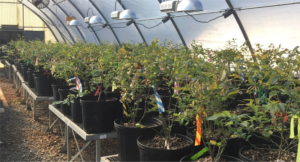
- At the end of the study, rhizosphere soil samples were obtained from each blueberry plant with destructive sampling to carryout analysis on soil biological health indicators for microbial activity and abundance. The parameters included soil respiration (Zibilske, 1994), urease activity (Mobley and Hausinger, 1989), phosphatase activity (Tabatabai, 1994), fluorescein diacetate hydrolysis activity (FDA) and abundance of ammonia-oxidizing bacteria (AOB) and archaea (AOA) (Mundepi et al., 2017). Microbial DNA was also extracted from the soil samples for comprehensive analysis of microbial community, which is ongoing.
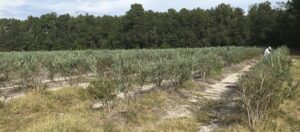
Figure 2: Blueberry plants in experimental field plots in Alma, GA - For the field study, we worked with two blueberry growers in Alma, Georgia, where we established experimental field plots in their farms in 2022 (Figure 2). One is organic whereas the other is conventionally managed farm. In each farm, three biostimulants along with a control were tested in randomized complete block design with four replications. The biostimulants in organic trial were Inocucor, Terra Grow and Fertiactyle GZ. The conventional plots received the following biostimulants: Huma Gro, Fertiactyle GZ and Terra Grow. Products were applied monthly between June and September 2022. Plant growth indicating parameters were measured in October 2022 when soil samples were also collected from the rhizosphere to test for soil biological health indicators as described above. The field trial was done only in Brightwell variety in both farms.
- Plant and soil data were statistically analyzed (analysis of variance) to test for the significance of biostimulants on blueberry growth and soil biological health parameters.
Objective 1: Characterize Georgia blueberry growers’ experience and expertise in using biostimulants
- We received a total of 68 surveys, of which 37 were usable responses (based on completion rate of at least 70% and removal of duplicate farms).
- Farm size of survey participants ranged from approximately 1 hectare (2 acres) to more than 256 hectares (635 acres), with an average farm size of approximately 49 hectares (~121 acres) (Table 1).
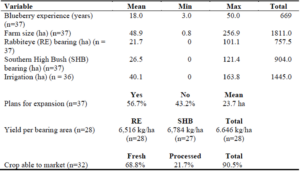
Table 1: General blueberry production information from the survey. - The completed surveys represent approximately 1,661 bearing hectares (4,105 acres), and 1,811 hectares (4,475 acres) in total planted area, an estimated 16% of blueberry production area in Georgia at the time of the survey.
- Farms in Bacon, Appling, and Clinch counties accounted for 58% of the survey responses and 61% of the total planted area in the survey, with most being from Bacon County (45% and 50%, respectively) (Figure 3). Farms in Brantley and Coffee counties also accounted for a significant amount of survey responses (13%) and total 34 planted area (30%). Other counties from across the state with producers represented in this survey include Baker, Burke, Candler, Colquitt, Jeff Davis, Meriwether, Mitchell, Tift, Ware, and Wilcox counties.
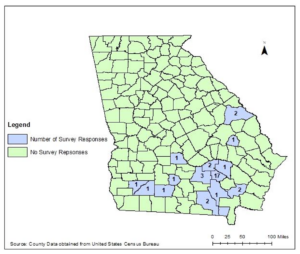
Figure 3: Number of Georgia Blueberry Grower Survey Responses by County. - The most common rabbiteye varieties reported by producers were ‘Brightwell’ (n=26) and ‘Premier’ (n=11), both of which are unpatented and the products of early blueberry cultivar development.
- Analysis of survey data indicates that plant biostimulant use among Georgia blueberry growers is not widely adopted and may be more prevalent among organic producers. Among survey participants in the present study, 27% percent reported currently using plant biostimulants in their production.
- When asked if their knowledge of plant biostimulants has changed at all within the last year, the majority (67%) reported no change in their level of understanding. Most participants (80%) reported the cost of plant biostimulants as “very much” or “somewhat” impacting their decision to use them.
- Analysis of interviews indicates that growers’ familiarity with plant biostimulants is highly variable. Growers are interested in researchers providing clarity regarding plant biostimulants: They want an unequivocal definition of what biostimulants are and how they work, as well as an impartial review of biostimulant products on the market and which benefits they can provide to the growers' production systems.
- Additionally, results indicate that there is still quite a bit of uncertainty among growers regarding plant biostimulants. Specifically, they are unsure as to where reliable sources of information can be found about biostimulants outside of university sources, and that some sources like chemical suppliers may be untrustworthy.
Objectives 2 &3: Determine the impact of biostimulants on blueberry growth and soil biological growth in a greenhouse and field studies.
Greenhouse Study Results
- From mixed model analysis, biostimulants did not significantly influence any of the plant growth and biomass parameters over the study period. Treatment effect was observed only on foliar pigment content indicators (chlorophyll, flavonols and anthocyanin) and differed by cultivar and time.
- For all the blueberry cultivars, no significant difference was detected in chlorophyl content between the Control and the biostimulants, except with the Brightwell cultivar. The biostimulant Terra grow resulted in significant higher chlorophyll content than Control in Brightwell in February, suggesting a potentially positive effect on the process of photosynthesis. Another exception was with the Legacy cultivar in which the Control had significantly higher chlorophyll content than the biostimulant Fertiactyl GZ in May.
- Terra grow was the only biostimulant that resulted in significantly higher anthocyanin content than the Control with the Legacy cultivar in June. For flavonols, the only cultivar in which significant difference between the biostimulants and the Control was observed was Brightwell in July. The biostimulant Fertiactyl GZ resulted in significantly lower flavonols content than the Control. Anthocyanin and flavonols contents are indicators of plant response to stress.
- Overall, the data indicate that most of the biostimulants did not significant affect the growth of the blueberry plants or their ability to respond to stress. Those biostimulants that affected any aspect of the plant growth did so in a manner that was not consistent over time or cultivar.
- In regard to the soil biological health indicators, no significant treatment effect was detected on soil respiration, urease and phosphatase activities. The biostimulant Fertiactyl GZ resulted in significantly higher FDA activity than the biostimulant Micron Nutrients but not against the Control with the Legacy cultivar.
- With AOA and AOB abundance, the biostimulants Inocucor, Huma Gro, Terra Grow and Micron Nutrients resulted in significantly higher abundance than Control in Farthing and Premier cultivars. This suggests these biostimulants might have stimulated growth of the microorganisms, potentially impacting the fate of nitrogen in the system. However, the results were not consistent across cultivars and biostimulants, and it was not easy to link the change to ingredients in the product. However, these are based on preliminary analysis, and we still have additional analysis to conduct on soil microbial community.
Field Study Results:
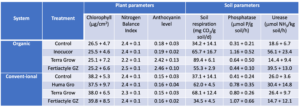
- As in the greenhouse study, we did not see any consistent effect of any of the biostimulants tested in the field on plant growth and soil biological health indicators. However, there were some trends. For example, anthocyanin levels were higher in plants with Terra Grow and Fertiactyle treatments in the organic farm (Table 2). Soil respiration was higher in plots that received Inocucor, Terra Grow and Huma Gro in both systems. Urease activity was elevated by Inocucor and Terra Grow. Some of these differences were not significant due to large variation among replications and hence the need to repeat this study for a second year. The field study was done only once during the project period because of COVID-related delays. We will continue the field study for the second year with support from other sources. Multiple year field study will provide better insight on the effect of the biostimulants on blueberry growth and soil biological health.
Presentations/Publications
- Preliminary survey results were presented at a UGA Extension virtual workshop with the purpose of sharing of information and recruitment for subsequent grower interviews on October 15, 2020 by graduate student Joel Kirksey who is part of the project.
- Renee Holland (project co-investigator) presented partial results of the survey to growers for sharing and recruitment on October 23, 2020 during Fruit Quality Workshop Update (virtual) hosted by UGA Extension.
- Kirksey, J. and Thompson, J. 2021. Understanding Growers’ Perceptions of Plant Biostimulants in Blueberry Production and Soil Biological Health. University of Georgia graduate seminar course, March 17, 2021, Athens, GA.
- Kirksey, J, JJ Thompson. 2021. Navigating Emergent Technologies and Scientific Uncertainty with Biostimulants in Georgia Blueberry Production. 2021 Joint Annual Conference. Association for the Study of Food and Society, Agriculture, Food and Human Values Society, Canadian Association for Food Studies, and The Society for the Anthropology of Food and Nutrition. (Virtual)
- Kirsey, J. 2021. Understanding Grower Perceptions of Plant Biostimulants in Georgia Blueberry Production. MS Thesis. University of Georgia.
- Kirksey, J and JJ Thompson. 2021. Understanding Grower Perceptions of Plant Biostimulants in Georgia Blueberry Production. ASA-CSSA-SSSA International Annual Meeting. Salt Lake City, UT.
- Kirksey, J. 2021. Understanding Grower Perceptions of Plant Biostimulants in Georgia Blueberry Production. MS Thesis. University of Georgia.
- Drocco, C. 2021. Evaluating the Impact of Biostimulants on Blueberry Growth and Soil Biological Health in a Greenhouse Study. MS Thesis. University of Georgia.
References
Mobley H.L. and Hausinger R.P. 1989. Microbial ureases: Significance, regulation, and molecular characterization. Microbiol. Rev. 53: 85-108
Mundepi et al. 2017. Ammonia oxidizers in grazing land with a history of poultry litter application. J. Environmental Quality 46:994-1002.
Scherm et al. 2001. A survey of horticultural and pest management practices of the Georgia blueberry industry. Small Fruits Review 1(4):17-28.
Tabatabai, M.A. 1994. Soil enzymes. In Methods of Soil Analysis, Part 2 – Microbiological and Biochemical Properties. R.W. Weaver, J.S. Angle and P.S. Bottomley (eds.) Soil Science Society of America, Inc. Madison, WI. pp. 775–834.
Zibilske, L.M. 1994. Carbon mineralization. In Methods of Soil Analysis, Part 2 – Microbiological and Biochemical Properties. R.W. Weaver, J.S. Angle and P.S. Bottomley (eds.) Soil Science Society of America, Inc. Madison, WI. pp. 835–906.
Education
None
Educational & Outreach Activities
Participation Summary:
- Preliminary survey results were presented at a UGA Extension virtual workshop with the purpose of sharing of information and recruitment for subsequent grower interviews on October 15, 2020 by graduate student Joel Kirksey who is part of the project.
- Renee Holland (project co-investigator) presented partial results of the survey to growers for sharing and recruitment on October 23, 2020 during Fruit Quality Workshop Update (virtual) hosted by UGA Extension.
Learning Outcomes
N/A at this moment
Project Outcomes
N/A at this time.
N/A at this time.